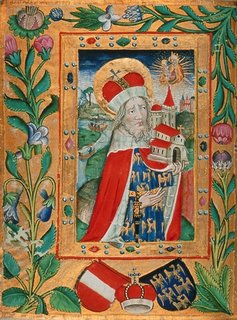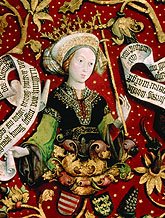The Legend of St Leopold

I'm back from Austria! Tired, with sore feet but refreshed after four nights at the wonderful Stift Klosterneuburg. Some of the Canons Regular are conversant with the Catholic blogosphere - one member of the community even has two blogs - so I should publicly acknowledge here their very generous hospitality.
Over the next few days and weeks I will gradually post various Austrian pictures and items - and I think a good place to start is the charming legend of St Leopold, one of the patrons of Austria and the founder of Klosterneuburg.
St Leopold III 'the Good' (1073-1136) was a member of the Babenburg dynasty (the dominant ruling house in Austria before the Habsburgs) and, from 1095, the Margrave of Austria. As well as consolidating Babenburg power and promoting peace, St Leopold is chiefly remembered as a founder of monasteries - Heiligenkreuz, Kleinmarazell, Seitenstetten and (most importantly) Klosterneuburg, which became his residence and (eventually) his final resting place. In fact my guest bedroom was almost directly above the chapel where his relics are kept, so I developed quite a devotion to him during my stay!

The legend of the founding of Klosterneuburg is a particularly charming one. St Leopold married Agnes, an influential lady in her own right as the widow of Frederick I of Swabia and the mother of Conrad, the future King of Germany (she was thus the mother of the Staufer dynasty). On the day of the wedding, a gust of wind blew her veil from her head as the happy couple were standing on a balcony of their hilltop castle at Leopoldsburg. A careful search was unable to retrieve it but Leopold made a vow that if he found the veil he would thank the Lord by building a church on the spot.

Nine years later (in 1114) he found the veil in an elderberry tree while on a hunting expedition. As can be seen in the painting above, Our Lady appeared and ordered the building of what would become Stift Klosterneuburg.
The Schleierlegende ('Legend of the Veil') is picturesque but full of historical inaccuracies - at the time of the wedding there was no castle on the Leopoldsburg and there was already a settlement at Klosterneuburg (in fact, there has been a human presence here since the Stone Age). The legend is only first mentioned in written form in 1371 and has since been much celebrated in art. But that's not to say that we should disregard the legend. The essential truth is that Klosterneuburg owes its foundation to Leopold and Agnes - and, given it is the story of a noblewoman's veil, perhaps Agnes played a central role.
The veil and parts of the elderberry bush are still kept in the Stift's Schatzkammer (Treasury) - the latter formerly being kept in the centre of the magnificent branched candlestick, donated to the Stift by its founders (below).

Ever since St Leopold's canonisation in 1485, his feast (15th November) has been a red letter day at Klosterneuburg, when his relics are displayed for public veneration (you can see his skull, dressed in the archdukal crown, in the picture below). Devotees traditionally slide down the side of a giant wine barrel (Binderstadel) that is kept in the monastery cellar and holds 56,000 litres - the ceremony is called Fasselrutschen. 'Where the Catholic sun doth shine there is laughter and good red wine.'



Labels: Saints



3 Comments:
Good to hear you had a good time, Father. Will you post the addresses for the Canon's blogs? Although, I suppose they will be in German.
BTW: You have been mentioned again in the newsletter! It goes on line at tea time this evening.
A few years ago, a group of us walked through the Vienna Woods from Vienna to Klosterneuburg. I still recall the sight of that wonderful monastery and its Imperial-Crown-topped dome getting closer and closer as we made our way there.
Hope you had a good break, Father.
It certainly sounds like a good break. And plenty of good stories for all.
Post a Comment
<< Home